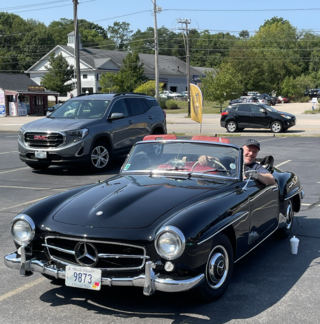Consumer Behavior
The Managed Consumer
The consumer is played and the merchant is paid.
Posted August 18, 2022 Reviewed by Vanessa Lancaster
Key points
- Consumer behavior reveals general psychological truths regarding judgment and decision-making.
- The middleman economy is efficient, mainly to the delight of the middlemen.
- Building relationships with producers, not only their products, is psychologically enriching.

Oh Lord, won't you buy me a Mercedes Benz?–J. Joplin
Having taught a course on Psychology in Business and Economics for years, I have learned that many students are keenly interested in consumer behavior. Why? Perhaps these students suspect that their consumer behavior is not optimal and that they stand to gain from a better understanding of their own biases and blind spots. Of course, some students assume that their decision-making as consumers is just fine, but others–the average person–are beset with psychological shortcomings, which are fun and enlightening to study. Students may also see consumer behavior as a window into general psychological questions regarding judgment and decision-making.
Students, who in ever larger numbers gravitate towards the various branches of the consulting industry, may take on the perspective of business organizations and seek a better understanding of suboptimal consumer behavior to advise firms on how to better exploit it. Students’ pervasive interest in branding is one sign of this sort of motivation. If they understand the psychology of branding, they seem to think they can help organizations brand themselves more efficiently and share in the gains.
But what is a brand if not a symbol with psychological connotations (Bastos & Levy, 2012)? When brands first emerge, they are often grounded in a comprehensible reality. The brand of Mercedes Benz used to signify well-made luxury cars produced in Untertürkheim, Germany. Cars under this brand are now made in 32 countries worldwide, and their quality and design are arguably less unique than they used to be. Brands, like stereotypes or myths, can be rather sticky psychological perceptions and beliefs (Brown et al., 2013). A good name may be hard to destroy (witness VW’s post-scandal resilience), but it is worth nurturing in the presence of eroding forces.
One potentially brand-eroding force is increasingly complex and lengthy supply chains. What is presented to the consumer as a unitary brand-name product is the accumulation and integration of multiple parts and processes, each of which might lay claim to its brand name. The complexity of production, from the extraction of minerals to the extraction of human labor to the application of engineering know-how and administrative routines, remains hidden behind a veil. The stereotyped brand name, and the knowledge and valuation that goes with it, is a heuristic decision shortcut, and like all shortcuts, it can be abused.
A purely psychological approach to branding easily turns to questions of how consumers’ perceptions of a line of products can be nudged or manipulated without asking first how the actual quality of the product can be improved. That, it is said, is the designers’ and the engineers’ job. Branding is to the marketeer and the psychologist.
In Direct: The Rise of the Middleman Economy and the Power of Going to the Source, Kathryn Judge (2022) explores and exposes both the efficiencies and the drawbacks of the contemporary economic system, in which multiple players have inserted themselves between the producers and the consumers of goods and services. Consumers have gained the conveniences of greater choice and of having to make fewer stops to do all their shopping. Yet, consumers seem no happier than they were decades ago; they are more likely to overbuy, they are less aware of the negative externalities associated with their purchases (e.g., environmental degradation, child labor), and they are largely unaware that middleman organizations pocket most of the efficiency gains.
If the transactions involving producers, middlemen, and consumers were open-book ultimatum games (Krueger, 2022), we might see many consumers decline to participate in the offered exchange and look elsewhere instead.
Judge cautiously avoids a simple set of equations where middleman business equals bad and direct producer-consumer business equals good. Yet, she notes many opportunities for consumers to cut out the middleman and buy goods and services directly from those who make them. Farmers' markets, so popular for ages in many countries, still only have a tentative foothold in the United States. This might be different if shopping for food were not seen as a chore to be completed as quickly as possible. The benefits of seeking out producers and engaging them in conversation are less obvious; they must be experienced to be appreciated. In other words, a re-learning process and a change of perception are needed.
Meanwhile, big retail businesses have perfected consumer management techniques, which may be called nudging or manipulation, depending on one’s inclination. Most producer-sellers cannot compete with this scientific marketing approach. Relying on sources cited by Judge, let us briefly note some classic, and in hindsight obvious, tactics deployed by Walmart to get customers to overbuy (their objective loss) while feeling they have saved money (a subjective gain).
The tactics listed by Yan (2019) and Cain (2019) boil down to two principles: size and salience. At Walmart, everything is large, from the building and the selection to the shopping cart itself. A customer who ends up checking out with nothing but a tube of toothpaste risks feeling foolish. The lowness of the prices is relentlessly impressed on the customer. Everything is a deal, either “every day” or currently (in which case you better hurry). Again, there is the subtle threat of attributed foolishness, for if you do not take advantage of a deal now, will you not pay more later?
When the slogan is “Save more–live better,” questions of branding and product quality are no longer center stage. If it is assumed that when quality passes a minimum threshold, getting more for less is better. Or is it? Branding campaigns and efficient shopping designs succeed only inasmuch as consumer preferences are fragile.
If it were the case that consumers know what they want, they would optimize their behavior; they would be less exploitable. Tactics like large shopping carts and brand-name products capitalize on consumers’ impulses. This is not necessarily objectionable. Why should one economic agent not try to take advantage of the weakness of another (within the confines of the law)? Yet, something seems amiss when the same consumers who just overbought the merchandise are left thinking they are the paragons of economic rationality.
According to Judge, seeking out producers directly will slow down the spending of money if we have the time and the will. The outing will be a shopping trip and not a shopping spree. Engaging with producers (or their immediate agents) will help build customer loyalty, and with that, the purchased good will be emotionally coded as a significant item. Now the psychological connotations are grounded in personal experience and not in a stereotyped notion of what is good and true and beautiful.

At the same time, it is still nice to be rich. If you are, you can travel to Untertürkheim and drive home–or at least to the Port of Antwerp–a shiny brand-name Benz.
References
Bastos, W., & Levy, S. J. (2012), A History of the concept of branding: Practice and theory. Journal of Historical Research in Marketing, 4(3), 347–368.
Brown, S., McDonagh, P., & Shultz, C. J. II. (2013). Titanic: Consuming the myths and meanings of an ambiguous brand. Journal of Consumer Research, 40(4), 595-614.
Cain, Á. (2019). 10 sneaky ways Walmart gets you to spend more money. Business Insider. https://www.businessinsider.in/slideshows/miscellaneous/10-sneaky-ways-…
Judge, K. (2022). Direct: The rise of the middleman economy and the power of going to the source. Harper.
Krueger, J. I. (2022). A reverse ultimatum game. Psychology Today Online. https://www.psychologytoday.com/us/blog/one-among-many/202207/reverse-u…
Yan, M. (2019). 9 sneaky ways Walmart makes you spend more money. Business Insider. https://www.businessinsider.com/how-walmart-gets-you-spend-more-money-2…




